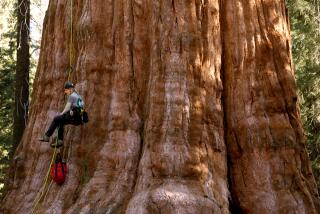O Christmas Tree, a Fungus Is Attacking Thy Branches
- Share via
Like the Grinch who stole Christmas, a foul fungus is threatening to spoil future holidays for Christmas tree growers from North Carolina to the Pacific Northwest. But new research exploring fungus-resistant alternatives may soon provide a measure of poetic justice in the form of healthy green fir.
A pernicious pest known as Phytophthora cinnamoni has long plagued Fraser fir trees grown in the foothills of North Carolina’s Appalachian Mountains, while the fungus has teamed up with seven of its close relatives to attack noble firs grown in the coastal valleys of Oregon and Washington. Together, the three states account for about 60% of the nearly 40 million Christmas trees produced in the United States every year. Plantation land lost to development, other natural enemies such as the imported balsam woolly adelgid (a wingless insect), and strong demand for high-quality Christmas trees have combined to exacerbate the problem.
“If you’re a grower and you spend thousands of dollars growing Christmas trees and then they all start dying, it’s a huge cost to eat,” said John Frampton, a Christmas tree geneticist at North Carolina State University. “It’s scaring the growers. It’s the No. 1 problem that growers talk to me about when I visit them in the mountains.”
Fraser firs, which account for virtually all of North Carolina’s $110-million Christmas tree industry, have proven particularly susceptible to the Phytophthora root rot. The Asian fungus, thought to have arrived in the United States in the 18th century and a close relative of the blight blamed for Ireland’s Potato Famine in the mid-19th century, attacks the plants through the root system and slowly moves up the trunk. “The tree will start turning kind of a yellowish color, lose needles, eventually turn brown and die,” Frampton said.
The fungus spreads primarily by water movement through the soil but can also spread by mud caked on animals, trucks, equipment and boots. Clay-based soil that retains water has become a no-planting zone in many areas because of the threat.
At higher elevations, where Fraser firs grow naturally, the fungus has been less of a problem because of cooler temperatures. At lower elevations where plantation owners grow the trees as cash crops, however, Phytophthora has reared its ugly head in at least 7% of North Carolina’s fir farms.
“I’ve heard of growers who have had plantations that were essentially destroyed by Phytophthora root rot,” Frampton said. “And then they went back 10 years later to plant and were not able to because of the fungus.”
But researchers and plantation owners are far from abandoning hope. Frampton said scientists are aiming to keep the fungus at bay by exploiting the natural resistance from other fir species and by searching for resistance within the Fraser fir population itself. He and his colleagues have been able to successfully graft Fraser firs onto the fungus-resistant roots of other trees, such as Turkish firs, momi firs from Japan, and Nordmann firs from Denmark.
As another approach, Frampton and his colleagues have artificially infected Fraser fir seedlings with the fungus and have found a small number that appear to have developed root rot resistance.
Researchers are continuing to screen different families of Fraser firs and collect the Phytophthora-resistant survivors, but so far that’s only 2% to 5% of the tested trees. The collection of about 40 to 50 survivors, however, may eventually provide the stock for resistant clones to give to growers.
More to Read
Sign up for Essential California
The most important California stories and recommendations in your inbox every morning.
You may occasionally receive promotional content from the Los Angeles Times.













